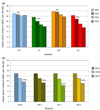Effects of Helicobacter pylori infection and smoking on gastric cancer incidence in China: a population-level analysis of trends and projections
- PMID: 19642005
- PMCID: PMC2904855
- DOI: 10.1007/s10552-009-9397-9
Effects of Helicobacter pylori infection and smoking on gastric cancer incidence in China: a population-level analysis of trends and projections
Abstract
Objective: Although gastric cancer incidence is declining in China, trends may differ from historical patterns in developed countries. Our aim was to (1) retrospectively estimate the effects of Helicobacter pylori (H. pylori) and smoking on past gastric cancer incidence and (2) project how interventions on these two risk factors can reduce future incidence.
Methods: We used a population-based model of intestinal-type gastric cancer to estimate gastric cancer incidence between 1985 and 2050. Disease and risk factor data in the model were from community-based epidemiological studies and national prevalence surveys.
Results: Between 1985 and 2005, age-standardized gastric cancer incidence among Chinese men declined from 30.8 to 27.2 per 100,000 (12%); trends in H. pylori and smoking prevalences accounted for >30% of overall decline. If past risk factor trends continue, gastric cancer incidence will decline an additional 30% by 2050. Yet, annual cases will increase from 116,000 to 201,000 due to population growth and aging. Assuming that H. pylori prevention/treatment and tobacco control are implemented in 2010, the decline in gastric cancer incidence is projected to increase to 33% with universal H. pylori treatment for 20-year-olds, 42% for a hypothetical childhood H. pylori vaccine, and 34% for aggressive tobacco control.
Conclusions: The decline in gastric cancer incidence has been slower than in developed countries and will be offset by population growth and aging. Public health interventions should be implemented to reduce the total number of cases. Electronic supplementary material The online version of this article (doi:10.1007/s10552-009-9397-9) contains supplementary material, which is available to authorized users.
Figures




References
-
- Ferlay J, Bray F, Pisani P, Parkin DM. IARC cancer base no. 5 Version 2.0. Lyon: IARC Press; 2004. GLOBOCAN 2002. Cancer incidence, mortality and prevalence worldwide.
-
- Howson CP, Hiyama T, Wynder EL. The decline in gastric cancer: epidemiology of an unplanned triumph. Epidemiol Rev. 1986;8:1–27. - PubMed
-
- Parkin DM. The global health burden of infection-associated cancers in the year 2002. Int J Cancer. 2006;118:3030–3044. - PubMed
-
- Haruma K. Trend toward a reduced prevalence of Helicobacter pylori infection, chronic gastritis, and gastric cancer in Japan. Gastroenterol Clin North Am. 2000;29:623–631. - PubMed
-
- Banatvala N, Mayo K, Megraud F, Jennings R, Deeks JJ, Feldman RA. The cohort effect and Helicobacter pylori. J Infect Dis. 1993;168:219–221. - PubMed
Publication types
MeSH terms
Grants and funding
LinkOut - more resources
Full Text Sources
Medical
Miscellaneous

